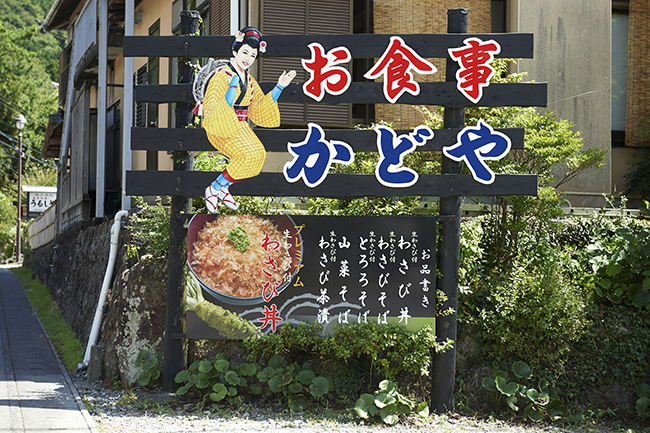Wasabi Bowl: A Flavorful Rice Dish with a Kick
Oct 17,2019
Wasabi Bowl: A Flavorful Rice Dish with a Kick
Oct 17,2019
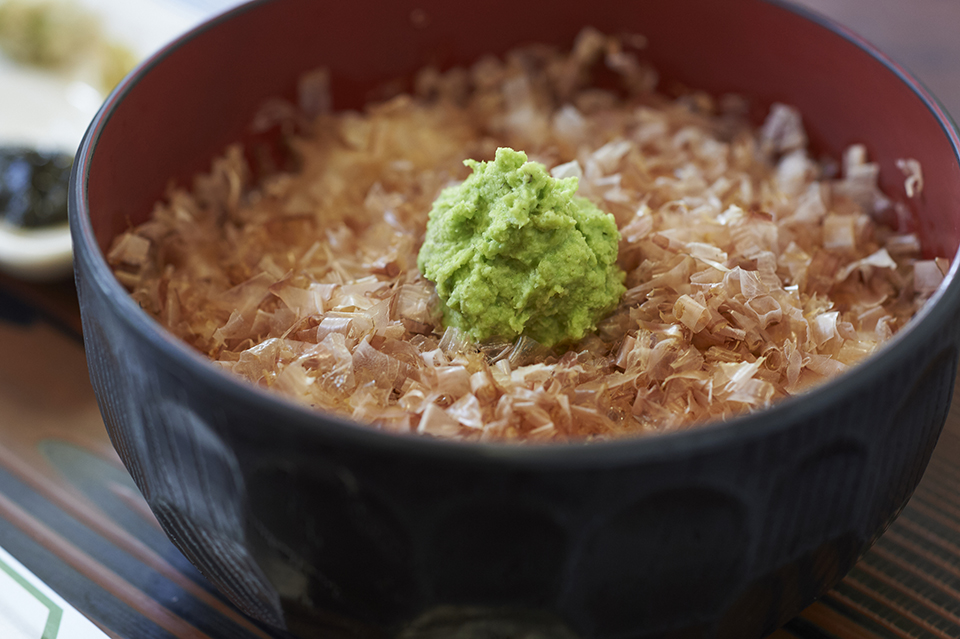

I headed south along the highway down the Izu Peninsula in Shizuoka Prefecture. My destination was Kawazu at the foot of Mount Amagi, which was made famous by the song “Amagi-goe” (Amagi Crossing). It’s also where Kawabata Yasunari’s novella The Dancing Girl of Izu is set. I was going there to eat wasabi on rice or “wasabi don” (literally “wasabi bowl”) at Wasabi-en Kadoya, a restaurant reportedly teeming with patrons from morning.
Izu, Shizuoka Prefecture, is Japan’s largest producer of wasabi. Growing wasabi is such a thriving industry, in fact, that wasabi is the city flower. What makes Wasabi-en Kadoya so popular is its wasabi don, made with delicious-tasting wasabi cultivated using spring water from Mount Amagi. It’s a simple enough meal: you grate the wasabi yourself, then plonk it on your rice. But it delivers a flavor experience to be enjoyed nowhere else. And its reputation has snowballed, especially since it was featured in a well-known foodie drama on TV. Nowadays, when the place opens at nine in the morning, crowds of people from outside the prefecture drop by for a bowl.
To learn more, I talked to the proprietor of Wasabi-en Kadoya, Inaba Nobuaki, a wasabi famer himself.
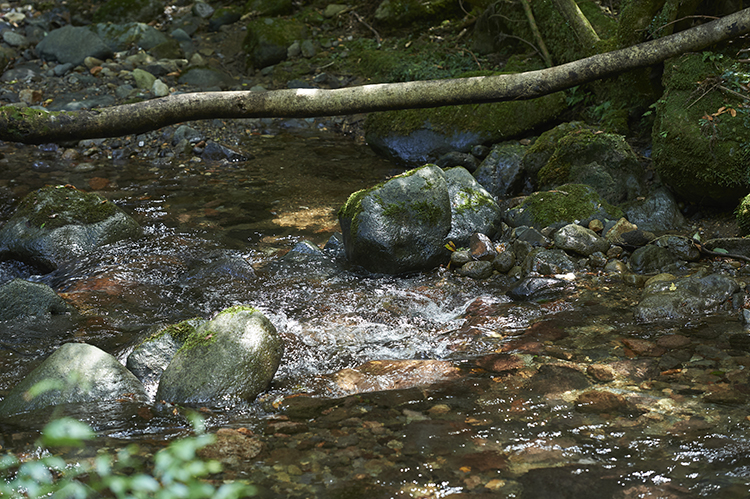
Nobuaki got straight down to business. “First let’s head to the wasabi paddy,” he urged. “It’s not an easy drive for first-timers, so I’ll take you in my car.” I hopped in, and we headed along a narrow mountain road lined with trees. A brook could be seen flowing at the side of the road.
During the drive he gave me a crash course on wasabi.
“Now, the history of wasabi goes back a long way. Wasabi is already mentioned on wooden tablets dating to around AD 600, during the Asuka period. It was originally a highly valued as a medicinal herb, so it was beyond the means of common people. I imagine Prince Shotoku ate it, though.”
In olden times, wasabi wasn’t used to season food so much as to prevent food poisoning. It possesses impressive antimicrobial properties.
“Today, wasabi is generally used as a condiment to enhance the flavor of sashimi and whatnot, but that wasn’t always the case. The Japanese once ate mainly freshwater fish and only started eating saltwater fish later. Saltwater fish may carry bacteria that cause enteritis. That’s why people started eating fish with wasabi, which kills bacteria. At first wasabi appears to have been blended with vinegar, not grated as it is now. But as soy sauce caught on in the Edo period, it came to be mixed with wasabi. Around the same time, someone came up with the idea of sandwiching wasabi between raw fish and rice. Thus the form of sushi we’re familiar with today, Edo-style sushi, came into being.”
Nobuaki was born into a family of wasabi farmers and wrote his master’s thesis on the plant. He’s so knowledgeable and passionate about the subject that he’s virtually the Wasabi Professor. His love of wasabi came across in his every word, and the car arrived at the wasabi paddy as I listened mesmerized.
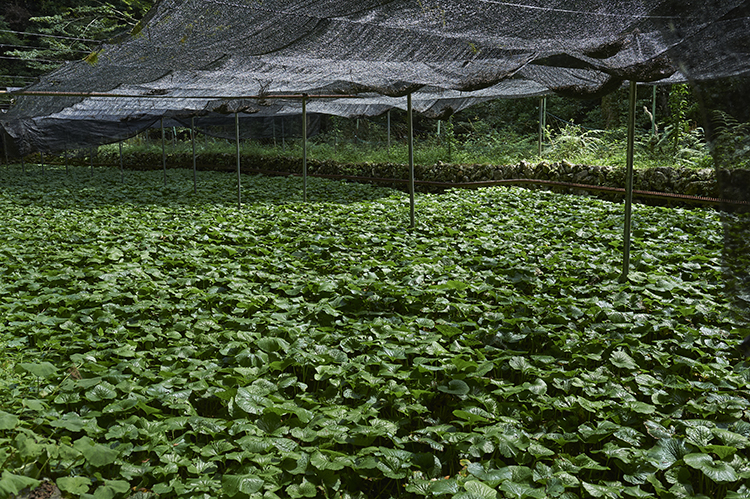
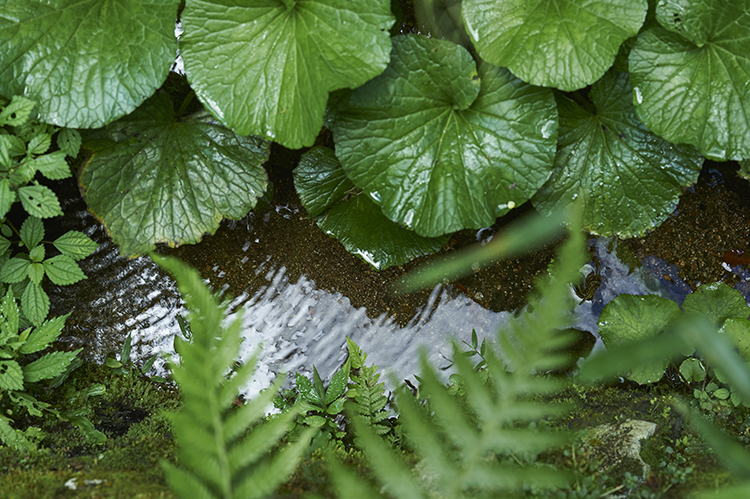
“The wasabi that grows in this valley is deliciously sweet,” said Nobuaki. I asked whether wasabi tasted different depending on where it was grown. “Yes, completely,” he replied.
“What makes a great-tasting wasabi is this. First you should be able to detect the aroma, then the pungency and sweetness, in that order. Wasabi is generally thought of as being hot and spicy, but if that’s unaccompanied by sweetness, it’s not genuine wasabi. Well, the wasabi grown in this valley sure is sweet. I doubt that anyone else would bother to measure the sugar content of wasabi, but I have, and the wasabi grown in this valley registered 9 degrees Brix.”
A sugar level of 9 degrees Brix rivals strawberries. Wasabi grown in other valleys may have a sugar level of around 6 degrees. I was surprised to learn that wasabi had such high sugar content.
“Have you ever heard that keeping cabbage in the snow in winter makes it taste sweeter and more delicious? When exposed to severe cold, crops store up sugar so they don’t freeze. It’s said that wasabi grown in pristine waters tastes better, but that’s not the only factor. To produce great-tasting wasabi, all the right conditions need to be in place. The water needs to be soft, which it is here due to the nature of the soil in Izu, which was originally a volcanic island. The temperature of the water is a factor too.”
The wasabi paddy itself is also part of the secret.
“The wasabi in this paddy is grown using a traditional cultivation technique called the laid-stone method. Viewed in cross section, the paddy has a layer of stones at the very bottom, then a later of gravel, then a layer of sand. The paddy itself therefore functions as a filtering mechanism, plus the wasabi can easily put down roots and obtain oxygen from the surrounding space. This is a time-honored method of cultivation. Creating a laid-stone bed from scratch would cost a fortune, so we carefully maintain the one we have when growing our wasabi.”
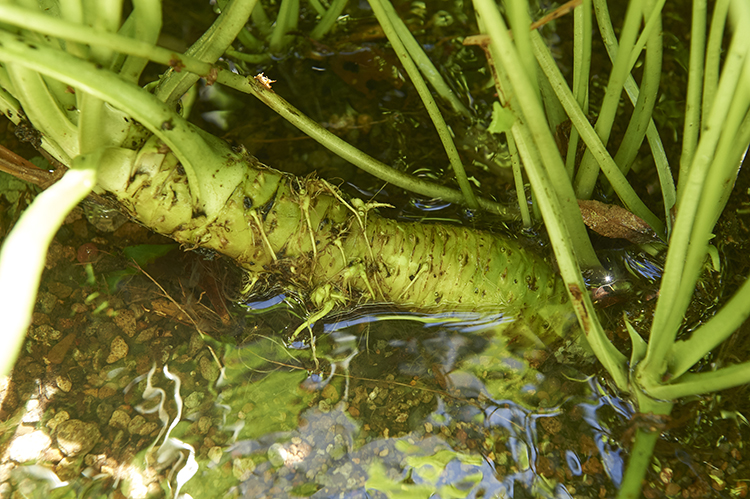
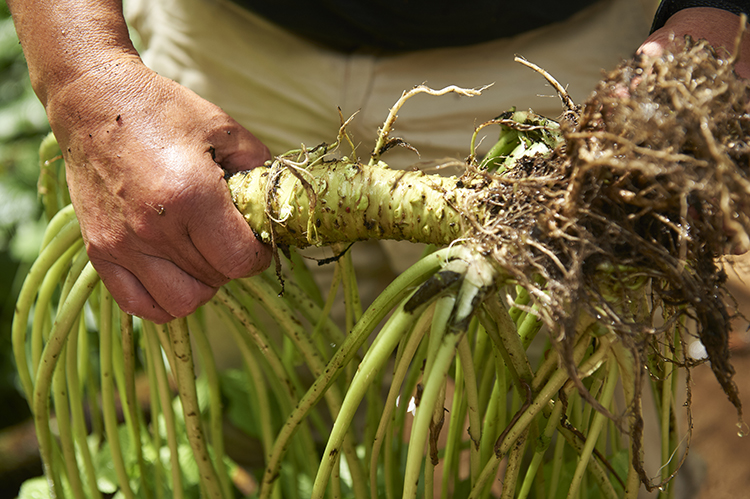
Another paddy we visited was just being harvesting. The harvested wasabi is thoroughly washed, and the roots are carefully removed one by one.
“Take a look at the upper part of the paddy. You can see spring water flowing in from there.”
I made my way up the paddy as I was told, submersing my feet in the cold water, and there it was, an incoming stream of water—cold, beautifully limpid spring water. “The taste of wasabi hinges on the water,” Nobuaki told me, and I saw exactly what he meant. The great flavor of Izu wasabi derives from this water.
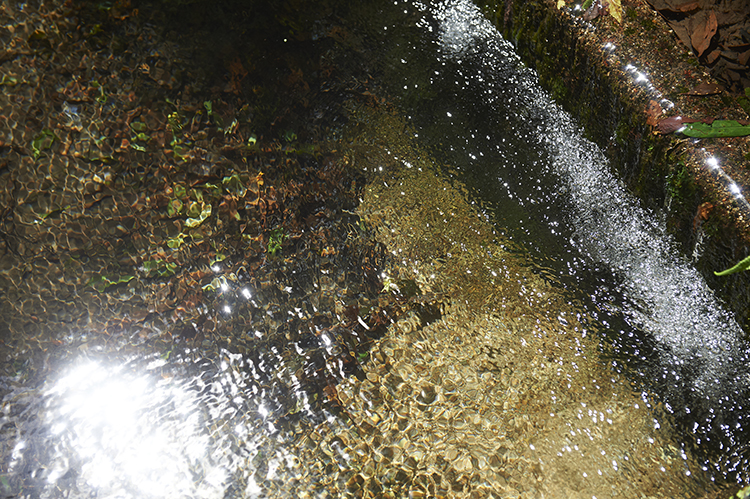
The wasabi harvested here is sorted by size. Some is used at Wasabi-en Kadoya, but most is shipped to market. It makes its way to sushi restaurants and other eateries or store shelves and ultimately the family pantry.
Wasabi is used at restaurants year-round, but I asked if there’s a particular time when it’s most in season. “It’s generally said to be in season in winter, but it tastes good at any time of year,” replied Nobuaki.
“Wasabi certainly tastes delicious in the winter. It’s very hot and spicy then, because it’s stopped growing and is packed with nutrition. In the spring, on the other hand, it’s tender and the pungency mellows, because water is stored up inside and the leaves and roots grow. The stems and flowers are therefore that much more delicious to eat. Wasabi offers a different taste experience each season.”
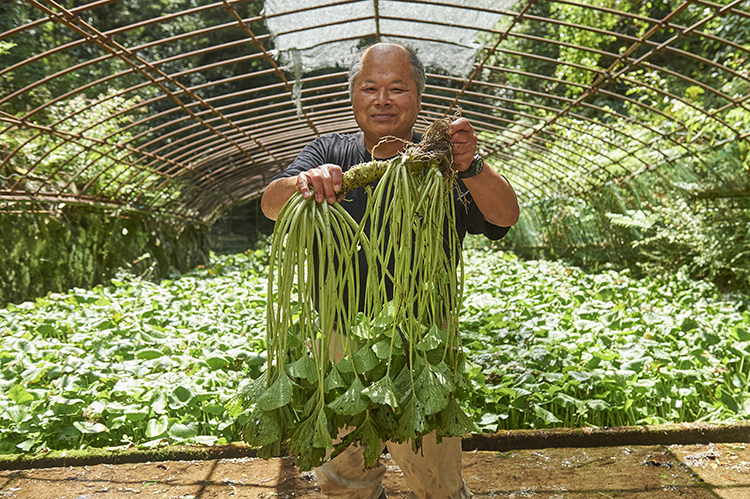
Inaba Nobuaki, proprietor of Wasabi-en Kadoya, holding a large wasabi plant
“Okay, it’s time to head back and have a wasabi don.”
Having just seen a wasabi paddy irrigated with beautiful spring water, I found my taste buds tingling at the very thought.
When I arrived at the restaurant and ordered a wasabi don, the server handed me some wasabi and a grating board and told me to grate the wasabi as I waited. Start at the top where the leaves once were, I was instructed, and grate the entire thing to the other end, where the taste is most potent.
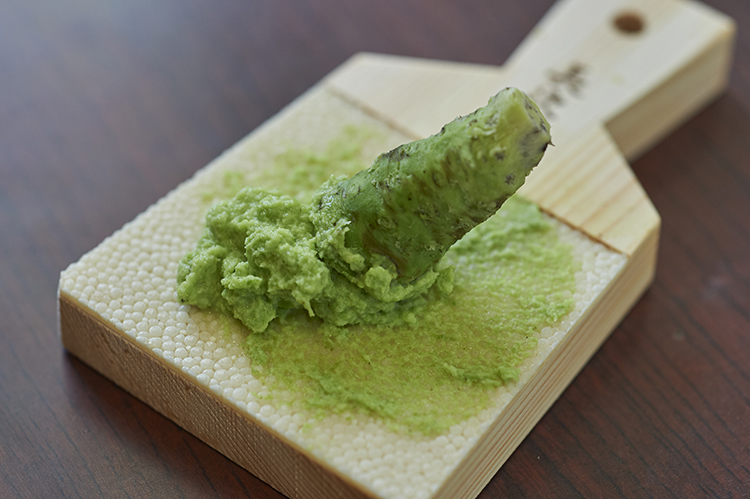
“The key to enjoying the flavor of wasabi lies in how finely you grate it. Breaking down the cells inside the plant while gently letting the air in results in a delicious flavor combining pungency and sweetness. Wasabi doesn’t react well to iron, which is why it’s best to use a sharkskin grating board rather than a metal grater. A sharkskin grating board lets you do a finer job of grating.”
So explained Nobuaki, and the aroma of wasabi gradually filled my nostrils as I obediently grated away on the sharkskin grating board. Tears started to well in my eyes, stimulated no doubt by the compounds released. I wiped them away as I grated, telling myself they were a sure sign that the cells of the plant were breaking down, enhancing the flavor. Meanwhile a bowl of rice topped with dried bonito flakes arrived from the kitchen accompanied by a small plate of side items like tsukudani preserves made with wasabi stalks.
“Place the grated wasabi in the center of the rice and drizzle soy sauce around it. Take a little bit of wasabi with each mouthful. You mustn’t pour soy sauce directly on the wasabi. It kills the flavor.”
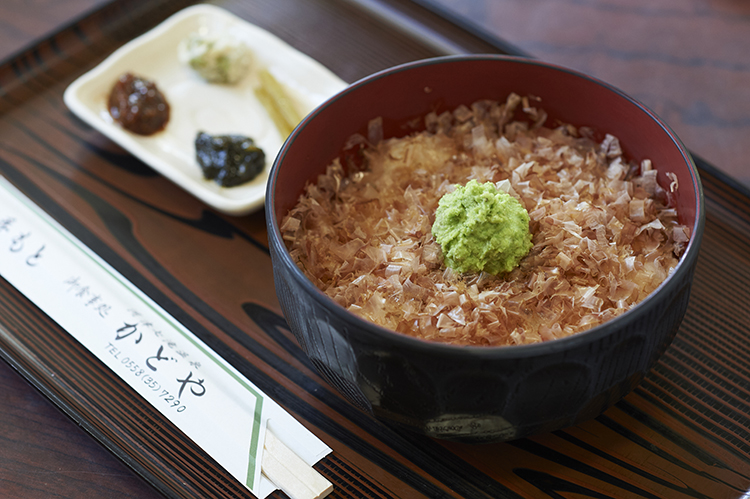
Many customers opt for the Wasabi Don with Fresh Wasabi (¥650). Other popular choices include Zaru Soba with Fresh Wasabi (¥800) and Wasabi Soba with Fresh Wasabi (¥950).
I poured a little soy sauce around, just as I was told, and took a mouthful with a little wasabi. The wasabi flavor gradually pervaded my mouth.
“That’s delicious! And it packs quite a punch!”
The sharp flavor characteristic of wasabi penetrated my nose, but it was a sharpness accompanied by a refreshing aroma. It possessed a noticeable afternote of sweetness, and I eagerly set to work on the rest of the meal. The simple combination of wasabi, rice, and bonito flakes proved irresistible. Occasionally I would add some of the tsukudani with wasabi stalks to vary the flavor, and in no time I had downed the entire bowl.
Wasabi don originated as a humble family meal. In Japan, you might have a meal consisting solely of rice and pickles when you have nothing else to eat. Well, wasabi farming households would eat bonito flakes and wasabi on rice in the same situation. Then Wasabi-en Kadoya decided to offer that as an off-menu item. It all began when a TV crew on a visit to the wasabi paddies asked Nobuaki whether there were any dishes made with wasabi that they could feature.
“Well, I said, here’s one way to eat wasabi that I’ve known since I was a kid,” he recalls. “And after that we started serving wasabi don at the restaurant.
Wasabi don first appeared as an off-menu item at the restaurant run by Nobuaki’s mother. But then one day he saw a shocking piece of news.
“Wasabi was named as one of the condiments least liked by people in Japan. ‘That certainly won’t do!’ I told myself. I figured there must be lots of people who have never experienced how good genuine wasabi tastes, though they may have eaten wasabi from a tube or wasabi-flavored snacks. Ever since, we’ve been plugging wasabi by giving wasabi don pride of place on the restaurant menu and launching our own website.”
Initially, says Nobuaki, the locals laughed at him. “Putting a family meal on the menu? That’s silly!” But it proved so delicious that customers came in droves. Then more places started to offer it, until it became a local culinary sensation.
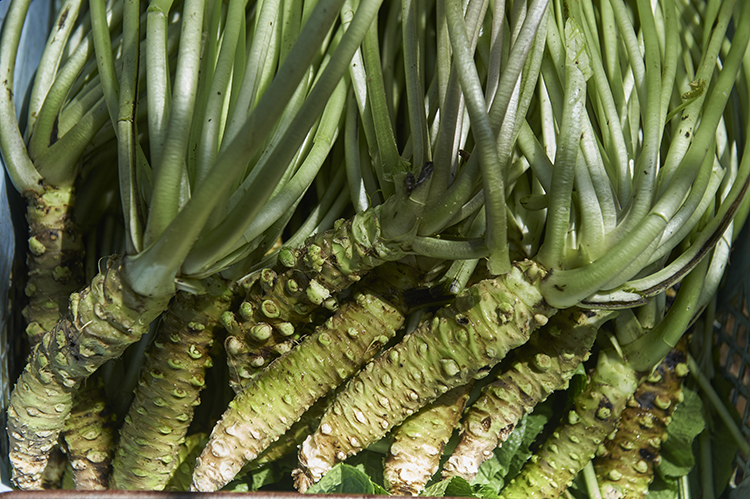
“Genuine wasabi is a healthy, delicious ingredient packed with flavor. The more people get to know the great taste of wasabi from the Izu Peninsula, the happier I’ll be.”
True to Nobuaki’s words, many people are doubtless visiting Izu again this morning to enjoy wasabi don—and experience the great flavor of the wasabi lovingly grown there.
